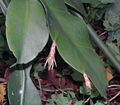Epiphyllum oxypetalum
| Epiphyllum oxypetalum subsp. var. | Dutchman's Pipe, Night blooming Cereus, Queen of the Night | |||||||||||||||||||||||||||||||||||||||||||||||||||||||
|---|---|---|---|---|---|---|---|---|---|---|---|---|---|---|---|---|---|---|---|---|---|---|---|---|---|---|---|---|---|---|---|---|---|---|---|---|---|---|---|---|---|---|---|---|---|---|---|---|---|---|---|---|---|---|---|---|

|
|
| ||||||||||||||||||||||||||||||||||||||||||||||||||||||
| ||||||||||||||||||||||||||||||||||||||||||||||||||||||||
This is the most commonly grown of the Epiphyllum specieswp.
| Standard Cyclopedia of Horticulture |
|---|
|
Epiphyllum oxypetalum, Haw. (Phyllocactus grandis, Lem.). Very large, sometimes 20 ft. long, with numerous short side branches, and these in the same plane with the main st., thin and lf.-like: fl. large (nearly a foot long), white, night-blooming (sometimes described as day-blooming). Originally from Mex., but said to be found in Honduras and Guatemala; also reported from Cuba, but surely not native there.—One of the commonest and best species in cult. CH
|
Stems erect, ascending, scandent or sprawling, profusely branched, primary stems terete, to 2-6 m long, flattened laterally, ligneous at base, secondary stems flat, elliptic-acuminate, to 30 cm x 10-12 cm, thin; margins shallowly to deeply crenate and ± undulate. Flowers produced from flattened portions, to 30 cm long, 12-17 cm wide, nocturnal, very fragrant. The principal odor component in the aroma is benzyl salicylate; pericarpel nude, slightly angled, green, bracteoles short; receptacle 13-20 cm long, 1 cm thick, brownish, arching, bracteoles narrow, ca 10 mm long; outer tepals linear, acute, 8-10 cm long reddish to amber; inner tepals oblanceolate to oblong, acuminate, to 8-10 cm long and 2,5 cm wide, whitish; stamens greenish white or white, slender and weak; style greenish white or white, 4 mm thick, as long as inner tepals, lobes many, pale yellow or white.. Fruit oblong, 12 x 8 cm, purplish red, angled.
Cultivation
An easily cultivated, fast growing epiphytewp. Needs compost containing plenty of humus and sufficient moisture in summerwp. Flower best when pot-boundAH. Should not be kept under 10°C (50°F) in winterwp. Can be grown in semi-shade or full sun. Extra light in the early spring will stimulate buddingwp, but over watering will cause bud dropsn. Giant, up to 10 inch flowers in late spring or early summer and large specimens can produce several crops of flowers in a seasonwp. Fertilize with low-nitrogen fertilizer before and after floweringsn.
Propagation
Cutting should root pretty easily in spring and summer. Allow cutting wound to dry for a couple of days before planting.
Pests and diseases
Fungal leaf and stem spot, mealybugs, scale insectsAH.
Cultivars
Gallery
If you have a photo of this plant, please upload it! Plus, there may be other photos available for you to add.
References
- Standard Cyclopedia of Horticulture, by L. H. Bailey, MacMillan Co., 1963
- American Horticultural Society: A-Z Encyclopedia of Garden Plants, by Christopher Brickell, Judith D. Zuk. 1996. ISBN 0789419432
- Sunset National Garden Book. Sunset Books, Inc., 1997. ISBN 0376038608
External links
- w:Epiphyllum oxypetalum. Some of the material on this page may be from Wikipedia, under the Creative Commons license.
- Epiphyllum oxypetalum QR Code (Size 50, 100, 200, 500)



